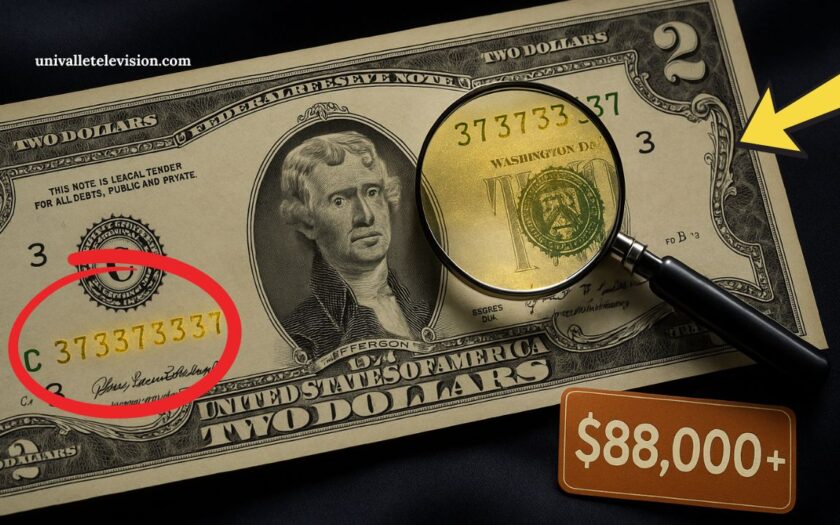A routine glance at your wallet might uncover something extraordinary — a 1976 $2 bill with a repeater serial number, potentially worth over $88,000. While most people treat $2 bills as novelty items or simple currency, certain serial number patterns can make them rare collector’s pieces with sky-high value.
In this case, a specific 1976 series note with repeating serial digits has caught the attention of collectors and sold for an eye-popping five-figure sum.
Could one of these still be circulating in everyday cash? Here’s everything you need to know.
What Makes This 1976 $2 Bill So Valuable?
The United States issued the 1976 $2 bill to commemorate the nation’s Bicentennial. While the majority of these bills are still worth face value, a select few are commanding tens of thousands of dollars due to rare serial patterns.
One such pattern is a repeater serial number, where digits repeat in a symmetrical pattern — such as 37373737 or 12121212. Combine this with high-grade condition, and you have a collector’s dream.
| Feature | Details |
|---|---|
| Series Year | 1976 |
| Denomination | $2 |
| Special Serial Pattern | Repeater (e.g., 37373737, 56565656) |
| Condition | Crisp, uncirculated, or mint condition |
| Estimated Value | $88,000+ for rare repeater serial notes |
What Is a Repeater Serial Number?
A repeater serial number is one in which a sequence of numbers is repeated, usually in a pattern of 2 or 4 digits. These numbers stand out due to their symmetry and rarity.
Examples of repeater serial numbers include:
- 37373737
- 12121212
- 56565656
The visual appeal and scarcity of such notes make them incredibly desirable for collectors, especially when they appear on limited series like the 1976 $2 bill.
How to Check If You Have One
Start by taking a close look at the serial number printed on the face of your $2 bill. Then:
- Identify a pattern – Look for sequences that repeat (e.g., 73737373).
- Check the condition – Bills in uncirculated or crisp condition are worth significantly more.
- Inspect for errors – Printing flaws, misalignments, or overprints can further increase value.
- Verify it’s a 1976 series – This adds historical significance tied to America’s Bicentennial celebration.
If your bill matches these traits, it’s worth getting a professional opinion.
Why Condition Matters
The value of any rare bill skyrockets when it’s in excellent condition. Uncirculated bills, which show no folds, stains, or wear, are prized above all.
| Condition | Impact on Value |
|---|---|
| Circulated (worn) | Minimal collector value |
| Crisp | Moderate increase in value |
| Uncirculated | Significantly higher market demand |
| Graded | Most trusted and valuable in auctions |
Professional grading services can authenticate your bill and assign it a numerical condition score, which directly affects how much collectors are willing to pay.
Auction Results and Market Demand
Although $2 bills with ordinary serial numbers may trade hands for a few dollars over face value, rare serial numbers in excellent condition have recently commanded upwards of $88,000.
These bills are usually sold through auctions or private collectors willing to pay a premium for rarity, especially when the serial number is paired with limited release years like 1976.
This kind of demand shows no signs of slowing down as more collectors enter the market and seek out the elusive serial variants that stand out from the rest.
Tips for Collectors and Casual Finders
If you’re curious whether you might be holding a valuable $2 bill, follow these tips:
- Store bills properly – Use a protective sleeve to prevent further wear.
- Don’t clean or press the bill – Any alteration can reduce its value.
- Consult an expert – Use reputable grading services to get an official evaluation.
- Track trends – Stay updated on collector forums and recent auctions to see what similar bills are selling for.
The chance of finding a valuable 1976 $2 bill with a repeater serial number might seem slim, but as this story shows, these rarities are still out there — possibly in your wallet, a drawer, or tucked away in old birthday cards.
With recent sales pushing past $88,000, it’s a reminder that everyday currency can hold incredible hidden value. The next time you come across a $2 bill, take a closer look — it might just be worth a fortune.
FAQs
What is a repeater serial number on a bill?
It’s a serial number where a pattern of digits repeats, like 37373737. These are rare and sought-after by collectors.
Can an old $2 bill really be worth $88,000?
Yes, but only if it has extremely rare features like a repeater serial number and is in pristine, uncirculated condition.
What should I do if I think I have a rare $2 bill?
Keep it safe, avoid handling it directly, and have it evaluated by a professional grading service to determine its value.

